 Image search results - "colors" Image search results - "colors" |

At 271 meters high, Mt.Hachiman-yama was the site of Hachiman Castle built by Toyotomi Hidetsugu in 1585. Now home to Zuiryuji temple of the Nichiren Sect, some of the castle's stone walls still remain. MAP
|
|

Hachiman-yama ropeway stationA short walk from Hachiman-bori canal.
|
|

Hachiman-yama ropeway takes only 4 min. to go up
|
|
|
|
|

Hachiman-yama map
|
|
|
|
|
|

Onegai Jizo-do Hall おねがい地蔵堂
|
|
|
|

View from Nishinomaru 西の丸跡
|
|

View from Nishinomaru
|
|

View from Nishinomaru
|
|

View of Lake Biwa from Nishinomaru on Mt. Hachimanyama in Omi-Hachiman.
|
|

Nishinomaru
|
|

Nishinomaru
|
|

Kitanomaru 北の丸跡
|
|

View from Kitanomaru
|
|

View from Kitanomaru
|
|

View from Kitanomaru
|
|

View from Kitanomaru
|
|

Nishi-no-ko Lake as seen from Kitanomaru atop Mt. Hachiman-yama.
|
|
|
|

Steps to temple
|
|
|

Hachiman-yama Castle wall
|
|

Site of Hachiman-yama Castle in Omi-Hachiman.
|
|

Castle wall
|
|

San-mon Gate 山門
|
|

Zuiryuji Temple of Nichiren Sect in the Honmaru 村雲御所瑞龍寺
|
|

Inside temple
|
|

Lookout in front of temple
|
|

View from temple grounds
|
|

View of Omi-Hachiman city center from Mt. Hachiman-yama.
|
|
|
|

Lookout in front of temple
|
|
|

Inari-do Shrine 稲荷堂
|
|
|
|

Castle wall and fall colors
|
|
|
|

Gift shop
|
|
|
|
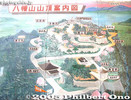
Hachiman-yama map
|
|

Genkyuen entrance gate at night in autumn.
|
|

From mid-Nov. to early Dec., the garden is beautifully lit up at night until 9 pm. Note that although the castle tower is also lit up, you cannot enter the castle grounds after 5 pm.
|
|
|
|

Hikone Castle and Genkyu-en fall colors
|
|

Hikone Castle and Genkyu-en Garden in fall
|
|
|
|
|
|
|
|
|
|
|

Torii at night in autumn. Hiyoshi literally means "Good Day" or "Fortunate Day." People pray here to have a good day. Having a good day every day leads to a good life. Taisha means "grand shrine."
|
|

Omiya Bridge at night in autumn when they light up the leaves.
|
|

Torii and gate at night
|
|

Path to shrine
|
|

Hyozu Taisha Shrine at night
|
|
|

Hyozu Taisha Shrine's Japanese garden at night in fall. It's really beautiful. Like someone painted colorful autumn leaves on a black canvas.
|
|
|
|
|

Mini concert at night. They had a few solo musicians playing romantic night songs like Twinkle, Twinkle Little Star. Very nice.
|
|
|
|
|
|
|
|
|
|

Romon Gate at night in fall.
|
|

Located in Higashi-Omi and established by Shotoku Taishi in 609, Hyakusaiji temple is Shiga Prefecture's oldest temple and one of Japan's oldest. It belongs to the Tendai Buddhist Sect. MapThe temple's terraced slope had many temple residences for hundreds of monks training here. National Historic Site
|
|

The two main areas are the hillside garden and the main worship hall. Most people visit the garden before climbing up the stone steps to the main worship hall. This is the long route to the temple. The tour buses go up to a closer gate.
|
|

This is near the bus stop.
|
|

The hillside garden gives a good view of Lake Biwa. The main temple hall worships an 11-faced Kannon statue carved by Shotoku Taishi. Admission 500 yen.
|
|
|

Autumn leaves. In its heyday, Hyakusaiji was home to 1,300 priests, before the temple was burned by Oda Nobunaga.
|
|

Entrance for tour bus passengers and car owners. This is the short-cut way to the temple.
|
|
|
|
|

Hyakusaiji temple Garden
|
|
|

Hillside garden
|
|

You can hike up the hillside garden.
|
|
|
|
|
|
|
|
|

View from top. Hazy weather made it difficult to see the scenery.
|
|

Landmarks seen from hilltop (on clear days)
|
|
|
|
|
|

Hyakusaiji temple
|
|
|
|
|
|

Steps to main temple
|
|
|

Niomon Gate
|
|

Hyakusaiji's Niomon Gate with giant straw sandals
|
|

More steps
|
|

Hyakusaiji's Main temple hall (hondo). Important Cultural Property.
|
|

Inside hondo, Hyakusaiji
|
|
|
|
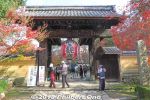
Kongorinji is a Tendai Buddhist temple established in 741 and the middle temple in the Koto Sanzan Temple Trio. The main temple hall is a National Treasure housing an 11-faced Kannon statue and 13 other statues designated as Important Cultural Properties.This is the Somon main gate to the temple. 総門
|
|
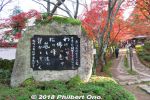
The temple was first built in 741 as ordered by Emperor Shomu. It later became a Tendai Buddhist temple in 850. It is famous for "blood-red" maple leaves in autumn.
|
|
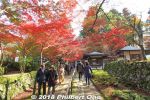
Off-season, normally you take a taxi (15 min.) from JR Inae Station if you don't have a car. There's a regular taxi that leaves the station once an hour.
|
|
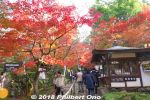
Temple ticket admission booth. ¥500 拝観受付
|
|
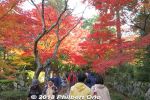
After the ticket admission booth, it's a delightful and colorful path to the temple.
|
|
|
|
|
|
|
|
|
|
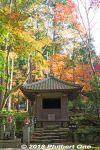
The first building you see. Nishiya-do hall housing Amida Nyorai buddha. Built in the Edo Period. 西谷堂 阿弥陀如来
|
|
|
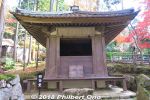
Nishiya-do hall housing Amida Nyorai buddha. Built in the Edo Period. 西谷堂 阿弥陀如来
|
|
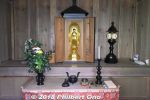
Inside Nishiya-do hall housing Amida Nyorai buddha. 西谷堂 阿弥陀如来
|
|
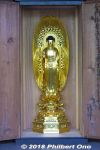
Nishiya-do hall housing Amida Nyorai buddha. Kongorinji Temple, Aisho, Shiga. 西谷堂 阿弥陀如来
|
|
|

Akamon Gate 赤門
|
|
|
|

The following photos were taken years earlier. Something things look the same, others have changed. Map of temple grounds.Established in 834 and located in Kora-cho town, Saimyoji is a Tendai Buddhist temple and the northern-most one in the Koto Sanzan Temple Trio.
The main temple hall, designated as Japan's first National Treasure, houses statues of gods with a carving of the 12 Oriental Zodiac signs on the head. Accessible by bus from Amago Station on the Omi Railway Line.
|
|

Front gate. This is where you pay the admission fee of 500 yen. During fall, the autumn leaves are brilliant, and you can enter the three-story pagoda (National Treasure) to see the wall paintings. MAP
|
|

Soon after you enter the temple, you see this "continuously blooming" cherry tree (fudan-zakura) planted next to a tree showing fall colors. This special cherry tree blooms in Nov. during the fall colors. 不断桜
|
|

Cherry blossoms which bloom in Nov. Designated as a Natural Monument and Cultural Property of Shiga. 不断桜
|
|
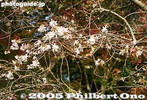
Cherry blossoms which bloom in Nov. This is full bloom. Not as glorious as the cherries in spring, but unusual to see them in Nov. 不断桜
|
|

Crossing the Meishin expressway. There's a bridge over a busy and noisy expressway which you cross to get to the other side of the temple grounds.
|
|

The path was a stunning showcase for autumn foilage.
|
|

Incredibly beautiful
|
|
|

Autumn leaves and stone wall
|
|
|
|
|
|
|
|

Stairs to autumn heaven. Up to here, the path was just filled with colors. And more still awaited.
|
|

At the top of the stairs
|
|
|
|
|

Nitenmon Gate to main temple (Hondo)
|
|

View from gate
|
|

View from gate
|
|
|
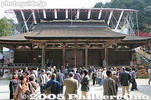
Japan's first National Treasure undergoing renovation of the roof. Saimyoji temple's Hondo hall (National Treasure) in Kora, Shiga. 本堂In 1571, Oda Nobunaga ordered Saimyoji to be burned down right after scorching Enryakuji on Mt. Hiei. Fortunately, this Kamakura-Period main hall and the pagoda survived.
|
|

Saimyoji temple Hondo Hall (National Treasure) in Kora, Shiga. In 1571, Oda Nobunaga ordered Saimyoji to be burned down right after torching Enryakuji on Mt. Hiei. Fortunately, this Kamakura-Period main hall and the pagoda survived. 本堂
|
|

Temple grounds
|
|

Inside Saimyoji temple's Hondo hall.
|
|

Hondo grounds
|
|

Hondo grounds
|
|

3-story pagoda, a National TreasureIn 1571, Oda Nobunaga ordered Saimyoji to be burned down right after scorching Enryakuji on Mt. Hiei. Fortunately, this Kamakura-Period main hall and the pagoda survived. The pagoda is 23.7 meters high.
|
|

Oda Nobunaga burned Saimyoji right after scorching Enryakuji on Mt. Hiei. Fortunately, the main hall and the pagoda survived. 3-story pagoda, a National Treasure
|
|

3-story pagoda, a National Treasure
|
|

3-story pagoda, a National Treasure
|
|

Saimyoji's 3-story pagoda, a National Treasure.
|
|

During the peak autumn season in Nov., the public is allowed to enter the pagoda to view the precious paintings on the wooden walls and pillars.
|
|

Veil of autumn leaves. Only several people can fit inside the first floor of the pagoda at one time, so you may have to wait in line.
|
|

3-story pagoda and fall colors. Photography is not allowed inside, but I highly recommend going inside. Admission 1,000 yen.
|
|

Closeup of pagoda
|
|
|
|

Temple bell
|
|

Temple bell, donate 50 yen to ring it
|
|
|

11-faced Kannon statue
|
|

Miniature Kannon
|
|

Miniature Kannon. Pay money to have your name under one of them.
|
|

Horaitei garden
|
|

I thought the fall colors were most abundant at Saimyoji. We could also enter the 3-story pagoda, a National Treasure. (You cannot enter the pagoda at the other temples.)
|
|

Saimyoji was my favorite Koto Sanzan temple
|
|

Tourists come by the busloads
|
|

Convenient shuttle bus. Visit Kongorinji temple next.During the peak fall season from mid-Nov., you can buy an Omi Railway train/bus pass for only 1,800 yen to visit all three Koto Sanzan temples plus Eigenji Temple. Ride on the Omi Railway Line to the closest train station (Hikone or Yokaichi) and hop on a shuttle bus like this one to visit the Koto Sanzan Temple Trio, plus Eigenji. There's a shuttle bus every hour or so that shuttle between the four temples. The pass is good for 1 day.
|
|

Note: The following photos were taken years ago. More recent photos are at the beginning of this album. Kongorinji is a Tendai Buddhist temple established in 741 and the middle temple in the Koto Sanzan Temple Trio. The main temple hall is a National Treasure housing an 11-faced Kannon statue and 13 other statues designated as Important Cultural Properties.
They come by the busloads. If possible, you should avoid visiting the Koto Sanzan Temple Trio and Eigenji during the weekend in fall. If possible, you should avoid visiting the Koto Sanzan Temple Trio and Eigenji during the weekend in fall.
|
|

Front gate. The temple was first built in 741 as ordered by Emperor Shomu. It later became a Tendai Buddhist temple in 850. It is famous for "blood-red" maple leaves in autumn. Map
|
|

They come by the busloads. If possible, you should avoid visiting the Koto Sanzan Temple Trio and Eigenji during the weekend in fall. If possible, you should avoid visiting the Koto Sanzan Temple Trio and Eigenji during the weekend in fall. Stone marker.
|
|

Foilage on the path
|
|

Nice path with fall colors
|
|

More path foilage
|
|

It's all too beautiful
|
|
|
|

Finally we see a building
|
|

And more leaves
|
|

Entering the path of little stone Jizo statues
|
|

More Jizo statues
|
|
|

1000 Jizo statues. On Aug. 9, the Jizo statues are lit with candles.
|
|
|

On Aug. 9, the Jizo statues are lit with candles.
|
|

On Aug. 9, the Jizo statues are lit with candles. Kongorinji temple in Aisho, Shiga.
|
|

On Aug. 9, the Jizo statues are lit with candles.
|
|

Tour bus parking halfway up the mountain
|
|

Gate to main hall. Tendai Buddhist temple established in 741 and the middle temple in the Koto Sanzan Temple Trio.
|
|

Kongorinji's main temple hall is a National Treasure housing an 11-faced Kannon statue and 13 other statues designated as Important Cultural Properties. Aisho, Shiga.
|
|

Kongorinji's Temple Hondo, a National Treasure in Aisho, Shiga.
|
|

Temple Hondo, a National Treasure
|
|

Temple Hondo
|
|

Temple Hondo
|
|

3-story pagoda
|
|

3-story pagoda, reconstructed in 1978
|
|

3-story pagoda
|
|

Yellow and red
|
|

More yellow and red
|
|
|

3-story pagoda
|
|

3-story pagoda
|
|

Inside 3-story pagoda
|
|

Kongorinji's Main temple roof drowning in fall leaves
|
|
|
|
|
|

Temple bell
|
|
|

On Aug. 9, the Jizo statues are lit with candles.
|
|
|
|
|
|

Garden at Kongorinji
|
|

Garden
|
|

"Blood-red" maples
|
|

Garden
|
|

Garden
|
|

"Blood-red" maples
|
|
|
|
|
|
|